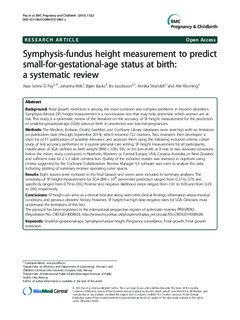| dc.description.abstract | Background: Fetal growth restriction is among the most common and complex problems in modern obstetrics.
Symphysis-fundus (SF) height measurement is a non-invasive test that may help determine which women are at
risk. This study is a systematic review of the literature on the accuracy of SF height measurement for the prediction
of small-for-gestational-age (SGA) status at birth in unselected and low-risk pregnancies.
Methods: The Medline, Embase, Cinahl, SweMed, and Cochrane Library databases were searched with no limitation
on publication date (through September 2014), which returned 722 citations. Two reviewers then developed a
short list of 51 publications of possible relevance and assessed them using the following inclusion criteria: cohort
study of test accuracy performed in a routine prenatal care setting; SF height measurement for all participants;
classification of SGA, defined as birth weight (BW) < 10th, 5th, or 3rd percentile or ≥ one or two standard deviations
below the mean; study conducted in Northern, Western, or Central Europe; USA; Canada; Australia; or New Zealand;
and sufficient data for 2 × 2 table construction. Quality of the included studies was assessed in duplicate using
criteria suggested by the Cochrane Collaboration. Review Manager 5.3 software was used to analyze the data,
including plotting of summary receiver operating curve spaces.
Results: Eight studies were included in the final dataset and seven were included in summary analyses. The
sensitivity of SF height measurement for SGA (BW < 10th percentile) prediction ranged from 0.27 to 0.76 and
specificity ranged from 0.79 to 0.92. Positive and negative likelihood ratios ranged from 1.91 to 9.09 and from 0.29
to 0.83, respectively.
Conclusions: SF height can serve as a clinical indicator along with other clinical findings, information about medical
conditions, and previous obstetric history. However, SF height has high false-negative rates for SGA. Clinicians must
understand the limitations of this test.
The protocol has been registered in the international prospective register of systematic reviews, PROSPERO
(Registration No. CRD42014008928, http://www.crd.york.ac.uk/prospero/display_record.asp?ID=CRD42014008928).
Keywords: Small-for-gestational-age, Symphysis-fundus height, Pregnancy surveillance, Fetal growth, Fetal growth
restriction | nb_NO |
| dc.description.localcode | © 2015 Pay et al.; licensee BioMed Central. This is an Open Access article distributed under the terms of the Creative Commons Attribution License (http://creativecommons.org/licenses/by/4.0), which permits unrestricted use, distribution, and reproduction in any medium, provided the original work is properly credited. The Creative Commons Public Domain Dedication waiver (http://creativecommons.org/publicdomain/zero/1.0/) applies to the data made available in this article, unless otherwise stated. | nb_NO |
